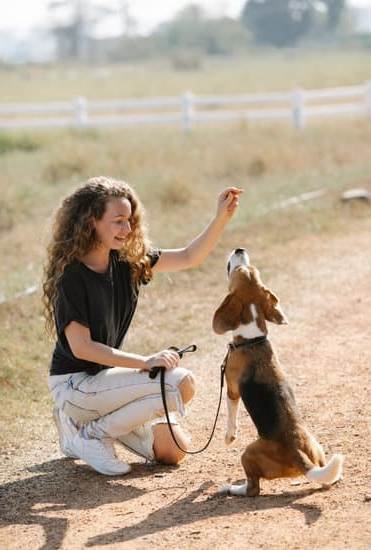Are you wondering how long dog training sessions should be? Training your furry companion is an essential part of responsible pet ownership, and the length of each session can greatly impact its effectiveness.
In this article, we will explore the science behind dogs and training, factors to consider before setting the length of dog training sessions, and the optimal duration recommended by professional trainers. Additionally, we will examine the benefits of short versus long training sessions for dogs and provide tips for keeping training engaging and effective.
Training sessions are crucial for ensuring that your dog develops good behavior, learns commands, and remains mentally stimulated. Just like humans, dogs have their own unique behavior and learning patterns that need to be understood in order to effectively train them. Factors such as age, breed, and temperament play a significant role in determining how long a training session should be. It’s important to take these factors into consideration when planning your dog’s training regimen.
Professional dog trainers have studied the most effective ways to train dogs and often have recommendations for the optimal length of training sessions. We will delve into these recommendations in this article to help you make informed decisions about the duration of your dog’s training sessions. By understanding these recommendations, you can ensure that your dog receives the appropriate amount of training without experiencing burnout or negative effects on their learning and retention capabilities.
The Science Behind Dogs and Training
Dogs have been domesticated for thousands of years, and during that time, they have developed certain behavioral patterns and learning capabilities. Understanding the science behind dog behavior and learning is crucial in designing effective training sessions for them. This section will explore the behavior and learning patterns of dogs, providing insight into how they process information and respond to training techniques.
Canine Behavior: Instincts vs. Learned Behaviors
One key aspect of understanding the science behind dog training is differentiating between instinctual behaviors and learned behaviors. Instinctual behaviors are innate responses that dogs have evolved to exhibit in specific situations, such as barking to alert their owners or seeking out food. On the other hand, learned behaviors are acquired through conditioning, repetition, and reinforcement. By understanding this distinction, trainers can tailor their methods to effectively address both types of behaviors.
Learning Patterns in Dogs
Dogs learn through a combination of classical conditioning (associating one stimulus with another) and operant conditioning (learning through consequences). They are also highly sensitive to body language, tone of voice, and environmental cues. Recognizing these learning patterns can help trainers communicate more effectively with their canine companions during training sessions.
The Role of Breed and Temperament in Learning
It’s important to note that different breeds have varying levels of intelligence, energy, and predispositions towards certain behaviors. Additionally, each dog has its own unique temperament, which influences how it responds to training. Some breeds may excel in certain types of training while struggling with others.
Likewise, some dogs may be more receptive to positive reinforcement methods, while others may require a firmer approach. Understanding these factors is essential in tailoring training sessions to meet the individual needs of each dog.
By gaining a deeper understanding of the behavior and learning patterns of dogs, trainers can develop more effective and tailored approaches to dog training. This knowledge provides valuable insights into how best to conduct training sessions that cater to each dog’s unique abilities and characteristics.
Factors to Consider Before Setting the Length of Dog Training Sessions
When it comes to training your dog, the length of the training sessions is an important factor to consider. Your dog’s age, breed, and temperament all play a crucial role in determining how long each training session should be. Understanding these factors will help you create an optimal training schedule that is not only effective but also enjoyable for your furry friend.
Age
The age of your dog is a significant factor when it comes to setting the length of training sessions. Puppies have shorter attention spans and may become easily fatigued, so their training sessions should be kept short and engaging. Older dogs may have more endurance but could also struggle with mobility issues, so their sessions should also be tailored to accommodate their physical limitations.
Breed
Different dog breeds have different levels of energy and motivation. High-energy breeds such as Border Collies and Australian Shepherds may require longer training sessions to stimulate them mentally and physically. On the other hand, toy breeds like Chihuahuas and Shih Tzus might do better with shorter, more frequent training sessions due to their smaller size and potential for quick burnout.
Temperament
A dog’s temperament can greatly affect how long they can focus during a training session. Anxious or easily distracted dogs may benefit from shorter sessions with frequent breaks, while more focused and eager-to-please dogs may be able to handle longer periods of training without losing interest. Understanding your dog’s individual personality traits will help you tailor the length of their training sessions for maximum effectiveness.
By taking into consideration these factors – age, breed, and temperament – you can customize your dog’s training sessions to suit their unique needs and abilities. This will not only make the process more enjoyable for both you and your dog but also lead to better results in terms of learning and behavior modification.
Optimal Length for Dog Training Sessions
When it comes to training your dog, the length of the training sessions plays a crucial role in their effectiveness. Professional trainers have extensive experience in understanding the attention span and learning capabilities of dogs, providing valuable insights into the optimal length for training sessions. By following their recommendations, you can ensure that your dog receives the most effective and efficient training possible.
Professional trainers often recommend that dog training sessions should typically last between 15-30 minutes. This duration is considered optimal for most dogs, as it allows them to stay focused and engaged without becoming bored or fatigued. However, it’s important to note that this recommendation may vary depending on factors such as age, breed, and temperament.
Factors such as age, breed, and temperament play a significant role in determining how long dog training sessions should be. For example, young puppies may have shorter attention spans compared to adult dogs, requiring shorter training sessions with frequent breaks. Similarly, high-energy breeds may benefit from shorter, more frequent training sessions compared to calmer breeds.
- 15-30 minutes: Recommended length for most dogs
- Shorter sessions for young puppies
- Consider breed and temperament when determining session length
By adhering to the recommendations of professional trainers and adapting the length of your dog’s training sessions based on their individual needs, you can ensure that they receive effective and enjoyable training experiences that promote learning and retention.
Overall, professional trainers provide valuable insights into understanding how long dog training sessions should be based on various factors. By following their recommendations and making adjustments based on your dog’s specific needs, you can create engaging and effective training sessions that contribute to their growth and development.
The Benefits of Short vs Long Training Sessions for Dogs
When it comes to training your dog, one important factor to consider is the length of the training sessions. The debate between short versus long training sessions has been a topic of discussion among dog owners and trainers. It’s essential to understand the impact that the duration of training sessions can have on a dog’s learning and retention.
Short training sessions, typically lasting around 10-15 minutes, have been favored by many trainers for their effectiveness in keeping the dog engaged and focused. Dogs have shorter attention spans compared to humans, so short bursts of training can prevent them from becoming bored or distracted. This approach also allows for frequent repetition of commands or behaviors, which can lead to better retention and understanding for the dog.
On the other hand, some trainers argue that longer training sessions, spanning 30-45 minutes, can be beneficial for more complex behaviors or tasks. These extended sessions provide more time for dogs to practice, learn, and refine their skills. However, it’s crucial to ensure that these longer sessions are structured in a way that prevents mental fatigue or frustration for the dog.
Ultimately, the ideal length of a training session will depend on your dog’s individual needs and abilities as well as the specific behavior or task being addressed. Understanding how long dog training sessions should be will require observation and flexibility to determine what works best for your furry companion. As with any aspect of dog training, it’s important to prioritize positive reinforcement, patience, and consistency regardless of session length.
Tips for Keeping Training Sessions Engaging and Effective
When it comes to training your dog, keeping the sessions engaging and effective is crucial for their learning and retention. One of the best ways to do this is by incorporating play and positive reinforcement into your training routine.
Dogs are naturally playful animals, and using play as a part of their training can make the sessions more enjoyable for them. Additionally, positive reinforcement has been proven to be one of the most effective training methods for dogs, as it rewards good behavior and encourages them to repeat it.
Incorporating play into your dog training sessions can be as simple as using their favorite toy as a reward for following a command or performing a trick. Tug-of-war, fetch, or hide-and-seek can also be incorporated into training sessions to keep your dog engaged and motivated. These types of activities not only provide mental stimulation for your dog but also strengthen the bond between you and your pet.
Positive reinforcement involves rewarding your dog with treats, praise, or affection when they exhibit the desired behavior or successfully complete a command. This method focuses on positive outcomes rather than punishment, which can help build trust between you and your dog while increasing their motivation to learn. By incorporating both play and positive reinforcement into your training sessions, you can create a fun and rewarding environment that promotes effective learning for your furry friend.
| Incorporating Play | Positive Reinforcement |
|---|---|
| Using toys as rewards | Rewarding with treats or praise |
| Engaging in games like tug-of-war | Building trust through positive outcomes |
| Creating a fun environment | Motivating learning through rewards |
Common Mistakes to Avoid When Training Dogs
When it comes to training your dog, it’s important to be mindful of the amount of time you spend on training sessions. Overtraining can lead to burnout for your furry companion, which may result in frustration and a lack of enthusiasm for future training sessions. So, how long should dog training sessions be to avoid overtraining and burnout?
Professional trainers recommend that dog training sessions should not exceed 15-20 minutes for puppies and 30-45 minutes for adult dogs. Puppies have shorter attention spans and energy levels, so keeping sessions short and engaging is crucial for their learning process. Adult dogs can handle longer sessions but still benefit from regular breaks and structured activities.
It’s also important to consider your dog’s breed, age, and temperament when determining the length of training sessions. High-energy breeds may require shorter, more frequent training sessions, while calmer breeds may be able to handle longer periods of focus. Additionally, older dogs may not have the stamina for extended training sessions compared to younger pups.
| Training Age | Recommended Session Length |
|---|---|
| Puppies | 15-20 minutes |
| Adult Dogs | 30-45 minutes |
Adjusting Training Sessions as Your Dog Progresses
In conclusion, the length of dog training sessions is an important factor to consider in ensuring that your furry friend learns effectively and retains the lessons. Understanding the science behind dogs’ behavior and learning patterns, as well as considering factors such as age, breed, and temperament, can help you determine the optimal length for training sessions. Professional trainers often recommend keeping sessions relatively short, especially for younger or easily distracted dogs, to maximize learning and prevent burnout.
It is essential to recognize that both short and long training sessions have their benefits, and it ultimately depends on your individual dog’s needs. Shorter sessions may be more suitable for puppies or dogs with shorter attention spans, while longer sessions can be beneficial for more experienced or focused dogs. It is crucial to keep in mind that engagement and positive reinforcement play a significant role in making training sessions effective regardless of their length.
As your dog progresses in training, it is vital to adjust the length and intensity of the sessions accordingly. Adapting to your dog’s individual needs and abilities will ensure continued progress and prevent frustration or burnout.
By avoiding common mistakes such as overtraining and incorporating play into the training routine, you can create a positive learning environment that fosters a strong bond between you and your pet. Ultimately, understanding how long dog training sessions should be goes hand in hand with being attuned to your dog’s unique personality and behavior.
Frequently Asked Questions
How Many Training Sessions a Day for a Dog?
The number of training sessions a day for a dog depends on the age, breed, and individual needs of the dog. Generally, it is advisable to keep training sessions short and frequent rather than long and infrequent.
How Many Hours Training Should You Do With a Pet Dog?
When training a pet dog, it is recommended to keep the training sessions between 5 to 10 minutes each, multiple times throughout the day. This helps maintain the dog’s focus and prevents them from getting bored or overwhelmed.
How Many Sessions Does a Dog Trainer Have?
The number of sessions a dog trainer has can vary depending on their schedule and the needs of their clients. Some may have multiple training sessions in a day, while others may have fewer but longer sessions. It ultimately depends on the trainer’s availability and workload.

Welcome to the blog! I am a professional dog trainer and have been working with dogs for many years. In this blog, I will be discussing various topics related to dog training, including tips, tricks, and advice. I hope you find this information helpful and informative. Thanks for reading!





